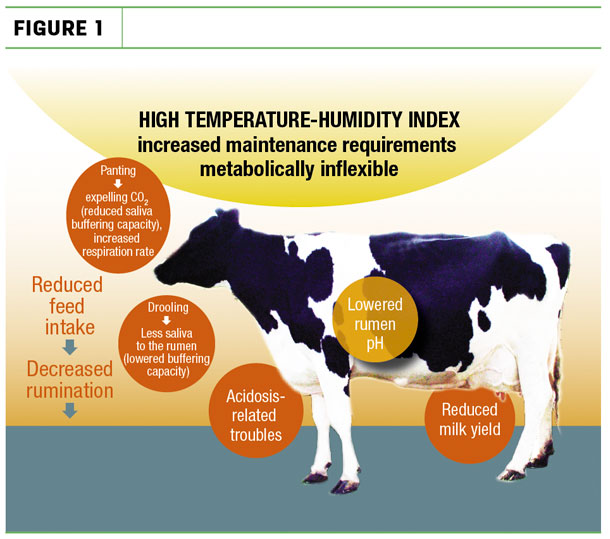As we get into the warmer weather, dairy producers and their consultants should be on the lookout for subtle changes in cow behavior, along with changes in forage and feedbunk stability. These changes are a result of increases in both the environmental temperature and relative humidity, as measured by the temperature-humidity index (THI).
The THI threshold for dairy cows is now recognized to be lower than previously thought at 68ºF.
Dairy cow challenges
The severity of a heat stress challenge depends on the heat abatement practices on a particular farm. Early studies with lactating dairy cows in climate chambers showed that a heat-stressed cow is an acidotic cow. Part of this is explained by an increased respiration rate, which in turn, increases carbon dioxide exhalation. This then perturbs the cow’s normal blood-pH buffering system.
During heat stress, the kidneys excrete bicarbonate to maintain a blood balance of 20 parts of bicarbonate to one part of carbon dioxide. Under normal conditions, the cow would use bicarbonate in saliva to help buffer rumen pH. However, under heat stress conditions, the body shifts bicarb usage to maintain the proper balance in the blood first.
This is further aggravated by the fact that rumination is decreased (so the cow actually makes less saliva) and because saliva is lost by drooling (Figure 1).

Therefore, good heat abatement strategies such as shade, soakers, misters and fans in the freestalls and holding areas are vital to managing heat stress, and so preventing acidosis on dairy farms.
The consequences of not providing good environmental heat abatement strategies for dry, transition and lactating dairy cows are well-documented and include:
- Lower dry matter intake (DMI)
- Loss of body condition
- Higher incidence of abortions
- Lower calf birthweight
- Increased incidence of metabolic disorders
- Lower average daily milk yield (by at least 5 pounds per cow daily)
- Lower milk component yield
- Decreased pregnancy rates
It is clear then, there are very strong financial incentives to invest in the necessary heat abatement strategies to ensure optimal cow comfort and well-being and to maintain productivity. Other best practices include always providing clean, fresh, palatable water and ensuring adequate linear trough space access (a minimum of 3 inches per cow).
Ration and feeding evaluations
Since investment in effective heat abatement strategies varies from farm to farm, many cows undergo some form of heat stress, be it mild, moderate or even severe. Knowing the rumen will be compromised and under threat of subacute ruminal acidosis (SARA), many farm teams focus on ensuring highly digestible forages are available.
Properly balancing the ration is complicated by the fact that corn silage is a common forage component in all dairy cow rations, and the starch in corn silage becomes more rumen-digestible over the course of storage, which is potentially disruptive to the rumen environment.
Consequently, many farm teams are adding a research-proven, rumen-specific active dry yeast (ADY) probiotic, like Saccharomyces cerevisiae CNCM I-1077, to the rations of transition and lactating dairy cows to aid in optimizing rumen function. The advantages of this ADY probiotic, even during heat stress, are:
- Decreased rumen lactate levels
- Enhanced rumen pH
- Improved ration neutral detergent fiber digestibility (NDFd) with higher milk component yield and feed efficiency
In addition to an ADY probiotic, both in-feed sodium bicarbonate and potassium carbonate are included in lactating cow TMRs to help meet the highly positive dietary cation-anion needs.
Feedbunk surfaces should be kept scrupulously clean, with all refusals removed daily. In the summer, the majority of farms will switch to at least a twice-daily feeding schedule – once in the morning and once in the evening – from the winter regime of once-a-day feeding.
Regular and frequent TMR push-up is paramount to promote DMI. One of the biggest challenges for the nutritionist and farm team is forage aerobic stability and its influence on TMR stability in the feedbunk.
Cows despise hot feed
As ambient temperatures rise, aerobically unstable ensiled feedstuffs and moist commodities can undermine TMR quality, DMI, rumen function and milk production.
Heating and spoilage in TMRs can usually be traced back to feeds that are aerobically unstable due to indigenous wild-spoilage yeast populations that have not been controlled. When ambient temperatures are 65ºF and above, spoilage yeasts can double in number every two hours in the air-exposed surfaces of silage bunks, bags or drop piles.
When aerobically unstable feeds are mixed into the TMR, spoilage yeasts have access to a fresh supply of highly digestible nutrients and can grow rapidly, causing the ration to heat, even if a farm moves to feeding multiple times per day.
The problem is only compounded when consumed by a heat-stressed cow with an already-challenged rumen function and can lead to reduction in milk and component yield. In studies with spoiled high-moisture shelled corn (HMSC) added to the TMR, average milk yield was reduced by 3 pounds per cow within 14 days with no depression in DMI.
Thus, aerobically unstable feeds mixed into TMRs can result in sudden and unpredictable losses in production with no hint of appetite loss. Another study showed high levels of wild spoilage yeast caused milkfat depression.
One management approach is to use TMR stabilizing products. However, this does not address spoilage yeast growth and associated DM and nutrient losses in the primary ingredient. Furthermore, TMR stabilizers used at the recommended label application rates can be expensive, ranging from 15 to 20 cents per cow per day.
The best solution is to ensure the ensiled forage and high-moisture grain inventories are treated with a research-proven and FDA-approved forage inoculant like Lactobacillus buchneri at the time of harvest using the recommended effective application levels.
Independent peer-reviewed research shows that the specific strain L. buchneri 40788 increases aerobic stability in the primary forage and in the resultant TMRs, and increases milk and component yield.
Setting your cows up for success
Despite recent improvements in environmental heat abatement strategies on farms, many dry, transition and lactating dairy cows are still exposed to some form of heat stress. This represents a triple threat to a cow’s metabolism and productivity:
- In the form of protective physiological shifts within the body
- The likely exposure to more readily digestible starch sources in the diet
- The negative effects aerobically unstable and high wild-spoilage organisms in forages and TMR have on rumen function
With research and field-proven technologies, like ADY probiotics and forage inoculants, as well as best-practice management strategies, the producer and nutritionist negotiate all three threats successfully. ![]()
Bob Charley has a Ph.D. in applied microbiology from the University of Strathclyde in Glasgow, Scotland. Renato Schmidt has a Ph.D. in animal nutrition from University of Delaware and is employed by Lallemand Animal Nutrition, North America as a forage products manager.
References omitted but are available upon request. Click here to email an editor.






